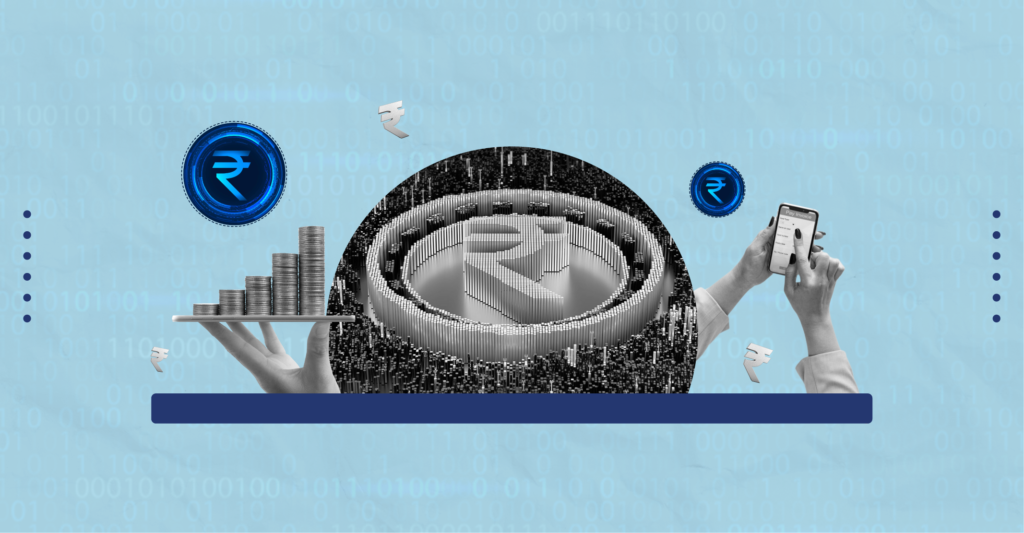Last Updated on Oct 25, 2022 by Anjali Chourasiya
How much paper currency do you currently have in your pocket? A majority of you will say very little to nothing! The digital revolution has taken us under its umbrella, catering to all our needs, including monetary management and transactions. Keeping this in mind, the Reserve Bank of India (RBI) has introduced the e-Rupee. In this article, let’s explore what it is, the journey of Central Bank Digital Currency (CBDC), the need for it, and answer some foundational questions related to the digital Rupee.
Table of Contents
The journey of Central Bank Digital Currency
India has made impressive progress towards innovation in digital payments. We have enacted a separate law for Payment and Settlement Systems, which has enabled an orderly development of the payment ecosystem in the country. From RTGS and NEFT to UPI and NETC, India has come a long way to develop a strong technology backend for the fintech sector.
Technology advancements have made it possible to develop a new form of money, i.e. Central Bank Digital Currencies (CBDC). RBI defines CBDC as the legal tender issued by a central bank in a digital form. An internal working group was set up by RBI in October 2022 to study the possibility of a CBDC. Based on the recommendations, a ‘Concept Note’ was released by the fintech department of RBI on 7th October 2022.
The Government of India has announced the launch of CBDC in its 2022 Union Budget. Soon, RBI will commence limited pilot launches for CBDC for specific use cases.
What is the e-Rupee?
CBDC is a digital form of currency notes issued by a central bank. The term e-Rupee or the digital Rupee is coined by the RBI for digital sovereign currency. It is a legal tender issued by a central bank in digital form. It will be an additional option to the currently available forms of money.
Currently, the RBI is issuing paper currency. CBDC will be the digital currency issued by the RBI, with many differences in the way it works and circulates throughout the country. Digital currency will not dismantle paper currency but will only be a different form of it.
The fintech department of RBI has issued a ‘Concept Note’ that explains the objectives, choices, benefits, and risks of issuing a CBDC in India. It also discusses the key considerations such as technology, design choices, possible uses, issuance mechanisms, etc. It examines the implications of the introduction of the e-Rupee on the banking system, monetary policy, and financial stability and analyses privacy issues.
Features of e-Rupee
- It is a sovereign currency issued by central banks in alignment with their monetary policy.
- It is freely convertible against commercial bank money and cash.
- It is a fungible legal tender which doesn’t require the holder to have a bank account.
- e-Rupee must be accepted as a medium of payment, legal tender, and a safe store of value by all citizens, enterprises, and government agencies.
- It offers the public broad access to digital money, which is free from credit and liquidity risk.
- The digital Rupee has offline functionality, provision of universal access devices and compatibility across multiple devices.
- e-Rupee will appear as a liability on the central bank’s balance sheet, similar to the paper currency.
Is it a cryptocurrency?
The biggest difference between cryptocurrency and the e-Rupee is that the e-Rupee is a legal tender in India and is backed by the RBI. In contrast to cryptocurrency, one e-Rupee can be exchanged for one Rupee in physical currency.
Cryptocurrencies have no intrinsic value. They are prone to volatility because their value predominantly lies in the limited supply and increasing demand, i.e. scarcity-induced. Whereas the digital Rupee will not suffer volatility as cryptocurrencies do, and being a sovereign currency, it offers trust, safety, and liquidity.
With the help of the e-Rupee, the RBI aims to meet the public’s demand for digital currency and avoid the damage caused by various private virtual currencies. In the ‘Concept Note’ by RBI, it is mentioned,
These digital assets undermine India’s financial and macroeconomic stability because of their negative consequences for the financial sector. Further, a wider proliferation of cryptocurrencies has the potential to diminish monetary authorities’ potential to determine and regulate monetary policy and the monetary system of the country, which could pose a serious challenge to the stability of the financial system of the country.
Why does India need the e-rupee?
Different jurisdictions have justified the adoption of CBDC for very diverse reasons. Some of them are:
- Jurisdictions with significant physical cash usage seek to make issuance more efficient, like Denmark and Germany.
- Faced with dwindling usage of paper currency, Central Banks seek to popularise a more acceptable electronic form of currency like Sweden.
- There are a lot of countries that have geographical barriers restricting the physical movement of cash. It gives motivation to the country to go for CBDC.
- There has been an increase in the use of private virtual currencies. Central Banks seek to meet the public’s need for digital currency and, thereby, avoid the damaging consequences of such private currencies.
Being a sovereign currency, CBDC or e-Rupee holds unique advantages such as trust, safety, settlement finality, integrity, and liquidity. There are various reasons for exploring the issuance of CBDC in India.
- e-Rupee can help reduce the cost associated with physical cash management.
- The digital Rupee, coupled with a sovereign guarantee, will promote the cause of digitisation to achieve a less cash economy.
- e-Rupee is expected to support the digital revolution, which is taking the world by storm. We can expect efficiency and innovations in the payment ecosystem with the e-Rupee as it offers the public broad access to digital money.
- It has the potential to alleviate the current challenges in cross-border payment and enhance the current system.
- The digital Rupee can provide the public with a risk-free virtual transaction capability, safeguarding the common man’s trust in the national currency.
- The Concept Note suggests that the e-Rupee will increase welfare for the poorer sections through financial inclusions.
The way forward
India is one of the first few countries to take a step forward in the direction of digital currency. Hence, the implementation of such a system will be a challenge. The potential impact on monetary policy from the introduction of CBDC is still unclear. It is purely speculative given that only limited CBDCs are currently in existence, as few nations have issued them to date. Hence, it will be interesting to watch what turn this space will take in the times to come!
FAQs about e-Rupee
1. How do you transfer e-Rupee?
The digital Rupee is transferable with the help of a token. In broad terms, a recipient will have a public key through which they can receive money, whereas a sender can transfer the money using a private key (consider this as a password).
2. Can you mine the digital Rupee?
Unlike cryptocurrency, the digital Rupee cannot be mined. RBI will issue the e-Rupee. Hence, cryptocurrency’s environmental and energy use concerns are unlikely to bother the digital Rupee.
3. Will the e-Rupee be anonymous?
Currently, a bank transfer is trackable, whereas a cash transfer is anonymous – you are not aware of who held that particular note in the past. But for the e-Rupee, the RBI Concept Note has proposed partial anonymity. It suggests that the transfer of small amounts can be anonymous, but not large amounts.
4. Can the digital Rupee be programmed?
There is a possibility that the e-Rupee can be programmed to achieve purposes like ensuring it is only spent for a particular sector. Further, it can be given for a limited time, like a coupon code or voucher, allowing RBI to stimulate demand and withdraw it when not needed.
All these features come with trade-offs, and hence, RBI has not finalised them yet.
5. Can the e-Rupee be transacted in offline mode?
Out of the 1.4 bn population, 825 mn people in India are not covered by the internet. Hence, the CBDC has to be functional offline to cater to the entire population of the country. The Concept Note by RBI proposed that the e-Rupee can be transacted without the internet, enabling access in regions with poor or no internet connectivity.
However, the risk of ‘double-spending’ will exist. It will be technically possible to use a CBDC unit more than once without updating the common ledger of CBDC. But, it can be mitigated to a larger extent by technical solutions and appropriate business rules, including monetary limits on offline transactions, says the Central Bank.
6. What are the advantages of the e-Rupee?
There are many advantages of the digital Rupee, as stated by RBI-
– Reduction in operational costs involved in physical cash management
– Support in financial inclusion
– Bringing efficiency and innovation to the current payment system
– Adding efficiency to the settlement system and boosting innovation cross-border payment system
– Reduce the risk associated with currently available private virtual currency.
7. Is the e-Rupee better than UPI?
Currently, UPI payments are made using the digital equivalent of existing currency notes – every Rupee transferred via UPI is backed by the physical currency. However, the digital Rupee is a legal tender which need not necessarily be backed up by physical currency.
Further, UPI payments rely on the settlement of the transacting banks with the RBI, whereas the e-Rupee will be transacting directly from RBI, providing potential for instant settlement.
8. Will CBDC earn interest?
If the digital Rupee earns interest, it might disrupt the existing financial system as people might withdraw their money from banks and convert it to an e-Rupee. In the Concept Note, the RBI mentioned, ‘The economic design of a CBDC should be least disruptive to the existing financial system. Moreover, CBDCs are an electronic form of sovereign currency and should imbibe all the possible features of currency. Since physical cash does not carry any interest, it would be logical to offer NonInterest bearing CBDCs.’




